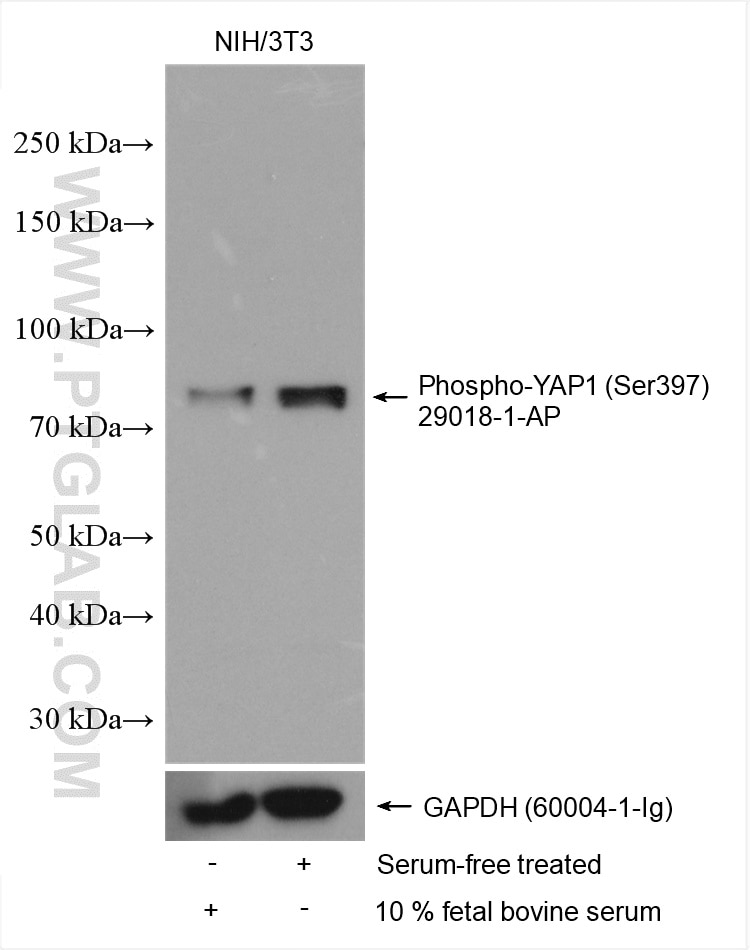Anticorps Polyclonal de lapin anti-Phospho-YAP1 (Ser397)
Phospho-YAP1 (Ser397) Polyclonal Antibody for WB, ELISA
Hôte / Isotype
Lapin / IgG
Réactivité testée
Humain, souris
Applications
WB, IHC, ELISA
Conjugaison
Non conjugué
N° de cat : 29018-1-AP
Synonymes
Galerie de données de validation
Applications testées
| Résultats positifs en WB | Serum-free treated NIH/3T3 cells, cellules NIH/3T3 traitées au sérum fœtal de bovin à 10 % |
Dilution recommandée
| Application | Dilution |
|---|---|
| Western Blot (WB) | WB : 1:2000-1:16000 |
| It is recommended that this reagent should be titrated in each testing system to obtain optimal results. | |
| Sample-dependent, check data in validation data gallery | |
Applications publiées
| WB | See 6 publications below |
| IHC | See 1 publications below |
Informations sur le produit
29018-1-AP cible Phospho-YAP1 (Ser397) dans les applications de WB, IHC, ELISA et montre une réactivité avec des échantillons Humain, souris
| Réactivité | Humain, souris |
| Réactivité citée | Humain, souris |
| Hôte / Isotype | Lapin / IgG |
| Clonalité | Polyclonal |
| Type | Anticorps |
| Immunogène | Peptide |
| Nom complet | Yes-associated protein 1, 65kDa |
| Masse moléculaire calculée | 504 aa, 54 kDa |
| Poids moléculaire observé | 75 kDa |
| Numéro d’acquisition GenBank | BC038235 |
| Symbole du gène | YAP1 |
| Identification du gène (NCBI) | 10413 |
| Conjugaison | Non conjugué |
| Forme | Liquide |
| Méthode de purification | Purification par affinité contre l'antigène |
| Tampon de stockage | PBS avec azoture de sodium à 0,02 % et glycérol à 50 % pH 7,3 |
| Conditions de stockage | Stocker à -20°C. Stable pendant un an après l'expédition. L'aliquotage n'est pas nécessaire pour le stockage à -20oC Les 20ul contiennent 0,1% de BSA. |
Informations générales
The transcriptional factors Yes-associated protein 1 (YAP1) and PDZ-binding motif (TAZ) act as downstream effectors of the Hippo pathway, and their subcellular location and transcriptional activities are affected by multiple post-translational modifications (PTMs). After phosphorylation, YAP1/TAZ binds to the 14-3-3 protein, which induces cytoplasmic retention of YAP1/TAZ. Moreover, phosphorylated YAP1/TAZ is likely to undergo ubiquitination degradation that is dependent on the β-transducin repeat-containing E3 ubiquitin protein ligase complex. The phosphorylation of YAP at Ser127 promotes its cytoplasmic retention, whereas phosphorylation at Ser397 induces degradation. (PMID: 29682330, PMID: 26039999)
Protocole
| Product Specific Protocols | |
|---|---|
| WB protocol for Phospho-YAP1 (Ser397) antibody 29018-1-AP | Download protocol |
| Standard Protocols | |
|---|---|
| Click here to view our Standard Protocols |
Publications
| Species | Application | Title |
|---|---|---|
Front Immunol The role of YAP1 in survival prediction, immune modulation, and drug response: A pan-cancer perspective | ||
Arch Biochem Biophys Oridonin suppresses the growth of glioblastoma cells via inhibiting Hippo/YAP axis | ||
J Nat Med Ruscogenin ameliorates dasatinib-induced intestinal barrier dysfunction via ErbB4/YAP and ROCK/MLC pathways | ||
Cell Death Dis PLAGL2 promotes bladder cancer progression via RACGAP1/RhoA GTPase/YAP1 signaling | ||
Mol Carcinog LATS-regulated nuclear-cytoplasmic translocation of SREBP2 inhibits hepatocellular carcinoma cell migration and invasion via epithelial-mesenchymal transition | ||
Biochem Biophys Res Commun IGF2BP1 enhances the stability of SIK2 mRNA through m6A modification to promote non-small cell lung cancer progression |


